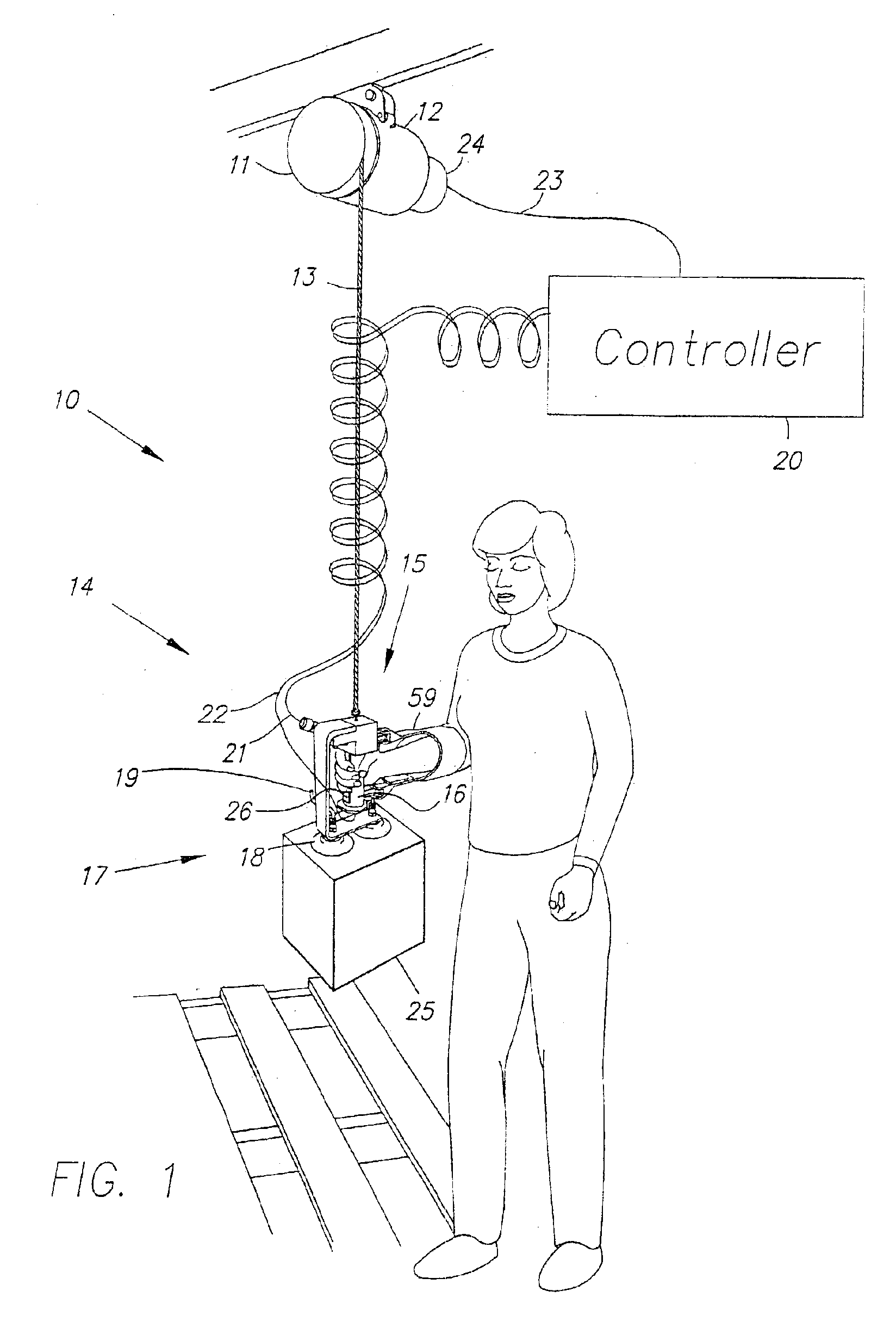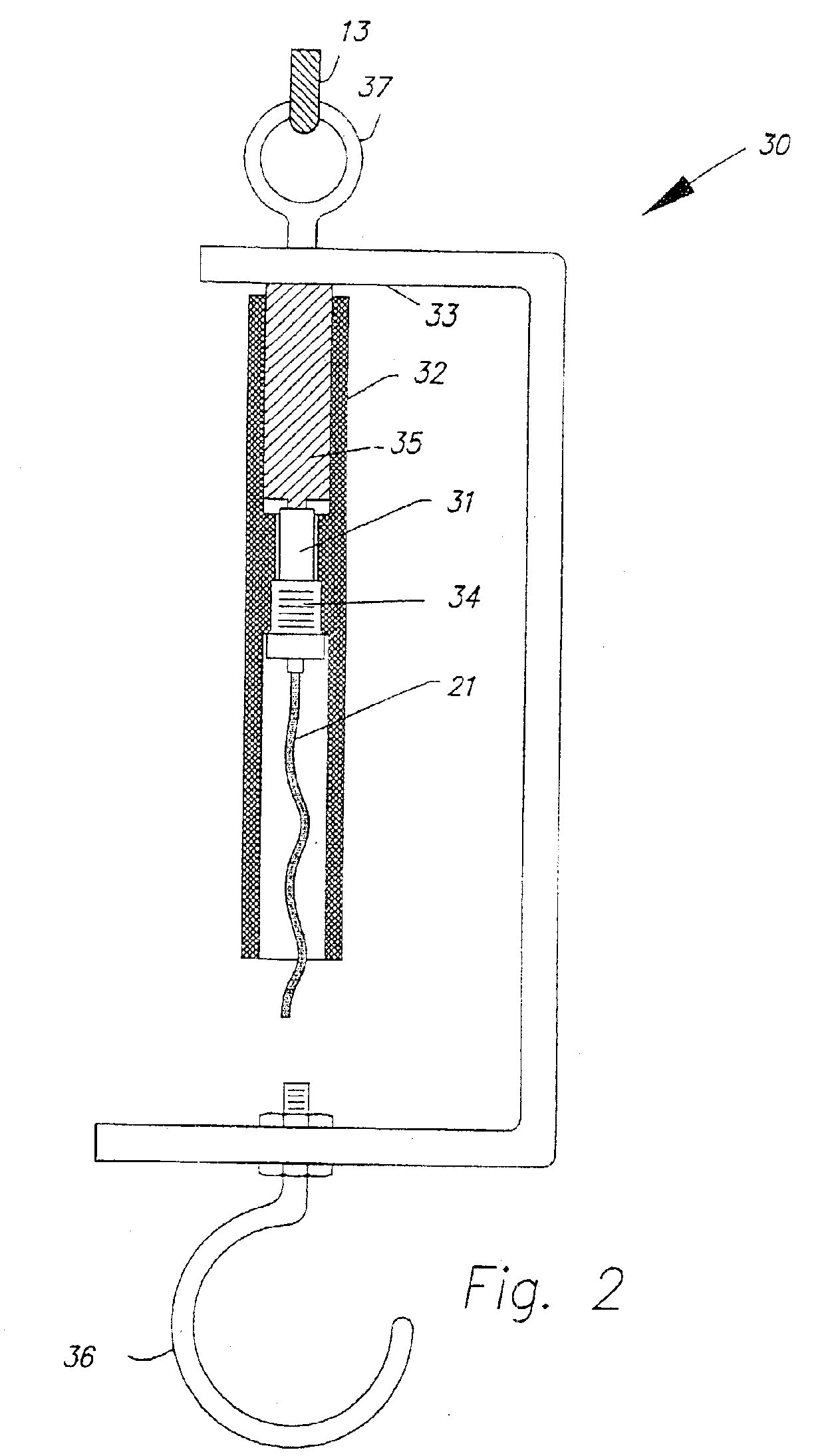Human power amplifier for lifting load with slack prevention apparatus
a technology of slack prevention and human power amplifier, which is applied in the direction of lifting equipment, load-engaging elements, gripping heads, etc., can solve the problems of limiting the acceleration and deceleration of heavy objects by the operator's strength, the system is not suited to maneuvering objects of various weights, and the balancer is not easily changed, so as to prevent slack in the line
- Summary
- Abstract
- Description
- Claims
- Application Information
AI Technical Summary
Benefits of technology
Problems solved by technology
Method used
Image
Examples
first embodiment
[0038]FIG. 1 illustrates the invention, showing a human power amplifier 10. At the top of the device, a take-up pulley 11, driven by an actuator 12, is attached directly to a ceiling, wall, or overhead crane. Encircling pulley 11 is a line 13. Line 13 is capable of lifting or lowering a load 25 when the pulley 11 turns. Line 13 can be any type of line, wire, cable, belt, rope, wire line, cord, twine, string or other member that can be wound around a pulley and can provide a lifting force to a load. Attached to line 13 is an end-effector 14, that includes a human interface subsystem 15 (including a handle 16) and a load interface subsystem 17, which in this embodiment includes a pair of suction cups 18. Also, shown is an air hose 19 for supplying suction cups 18 with low-pressure air.
[0039]In the preferred embodiment, actuator 12 is an electric motor with a transmission, but alternatively it can be an electrically-powered motor without a transmission. Furthermore, actuator 12 can als...
experiment 1
[0073
[0074]If Δv=0 for two different objects being maneuvered (i.e. the operator maintains similar operational speeds), then:
0=(GK+S)(Δf)+S(ΔW) (12)
[0075]Rearranging the terms of equation (12) results in equation (13): GKS+1=-Δ WΔ f(13)
[0076]Equation (13) indicates that an increase or a decrease in the load weight (ΔW) will lead to an increase or a decrease in the upward human force, if operational speed is expected to remain unchanged. In other words, if the load weight is increased, the operator needs to increase his / her upward hand force or decrease his / her downward force to maintain the same operational speed. The term (GK / S+1) in equation (13) is the force amplification factor. The larger (K) is chosen to be, the greater the force amplification in the system will be. Consequently, if the force amplification is large, the operator “feels” only a small percentage of the change of the load weight. Essentially, the operator still retains a sensation of the dynamic characterist...
experiment 2
[0077
[0078]If Δf=0, (i.e. operator decides to maintain similar forces on the end-effector for two different load weights), then equation (11) reduces to:
(1+SE)Δv=S(ΔW) (14)
[0079]This means that an increase in load weight, (ΔW), will lead to an increase of downward speed, if the operator maintains a constant hand force. Moreover an increase or decrease in the weight of the load, (ΔW), will cause a decrease or increase, respectively, in the upward end-effector speed for a given operator force on the end-effector. Essentially, the load falls faster and goes up slower if there is an increase in the load weight for a given operator force. From equations (13) and (14), it can be deduced that for an increase of load weight, the operator needs either to increase his / her upward force to maintain similar operational speed or to decrease his / her upward operational speed to maintain similar force on his / her hand. This dynamic behavior is very comforting and natural for the workers.
PUM
 Login to View More
Login to View More Abstract
Description
Claims
Application Information
 Login to View More
Login to View More - R&D
- Intellectual Property
- Life Sciences
- Materials
- Tech Scout
- Unparalleled Data Quality
- Higher Quality Content
- 60% Fewer Hallucinations
Browse by: Latest US Patents, China's latest patents, Technical Efficacy Thesaurus, Application Domain, Technology Topic, Popular Technical Reports.
© 2025 PatSnap. All rights reserved.Legal|Privacy policy|Modern Slavery Act Transparency Statement|Sitemap|About US| Contact US: help@patsnap.com



